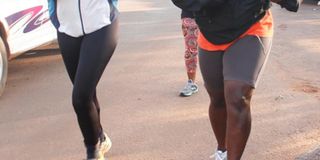How age and physical activity can lead to crumbling limbs

Athletes and people whose jobs require repetitive movement have a higher risk of developing osteoarthritis, due to injury and increased stress on certain joints. Photo by Abubaker Lubowa
What you need to know:
One of the effects of aging is the breakdown of cartilage in the skeletal joints, causing friction and wearing of bones. Beatrice Nakibuuka spoke to an expert on the management of this condition.
Osteoarthritis is a degenerative inflammatory joint disease that results from the breakdown of cartilage in joints usually due to aging. It usually affects the hip and knee joints.
The most vulnerable people are those in their 50’s but a younger person could suffer from the condition depending on the risk factors.
Dr Pereddy Somashekhara Reddy a visiting orthopaedic surgeon from Apollo Hospitals in New Delhi, India, says, “Osteoarthritis is brought about when the cartilage (which acts as a cushion between bones) in the joints breaks down, causing wearing of the bones as they rub together leading to swelling at the joints.”
Two types of arthritis
Rheumatoid arthritis has similar traits but is an autoimmune disease that is genetic can affect someone at any age and runs in the family.
Dr Somashekhara says, “Unlike osteoarthritis, Rheumatoid arthritis is an autoimmune disease. This type of arthritis occurs when the immune system which usually fights infection attacks the cells that line your joints making them swollen, stiff and painful.”
Rheumatoid arthritis is considered to be symmetrical arthritis which affects both joints uniformly. The exact trigger of this auto-immune disorder is not known. Osteoarthritis on the other hand is usually asymmetrical where only one joint is affected.
“Symptoms of rheumatoid arthritis include a throbbing and aching pain, more regular in the mornings or during cold weather and is normally felt while resting rather than during or any after activity,” remarks Dr Somashekhara.
A person also suffers inflammation in the affected joints which causes swelling, pain and deformity.
What causes osteoarthritis?
According to Dr Somashekhara, despite the prevalence of the disease, 90 per cent of the causes of osteoarthritis are not known. However, there are many different risk factors which play a role in causing the joint disease.
“Athletes and people whose jobs that require repetitive movement have a higher risk of developing osteoarthritis, due to injury and increased stress on certain joints,” says Dr Somashekhara.
Incidences of osteoarthritis increase with age due to wear and tear in the joints. The older one becomes, the more wear on his joints.
The knees carry the burden of someone’s body weight and are particularly at risk because for any extra weight gained, the body exerts more pressure on the hips and knee joints.
“Gaining weight increases the likelihood of developing osteoarthritis. Increased body weight adds stress to lower body joints which is a well-established factor in the progress of osteoarthritis.”
Rheumatoid arthritis, a genetic joint disease also plays a role in the progression of osteoarthritis. Congenital and inherited bone abnormalities that affect joint shape cause cartilage to form abnormally such as in people who are bowlegged or double-jointed. These may develop osteoarthritis.
Symptoms
Osteoarthritis affects the cartilage of a person’s joints.
The result is pain in the joints as the bones rub directly against each other. Small bone fragments begin to break away, which can cause inflammation and disability.
•Painful swollen joints
•Stiffness in the joints
•Pain while walking or after normal activity, such as squatting, standing
Treatment advice
Osteoarthritis is hardly preventable but its progress can be slowed by medication, dietary supplements and physiotherapy.
If you get severe pain during daily activities such as walking or lifting something, Dr Somashekhara advises that you seek an orthopaedics’ advice as soon as possible to find ways to make life more comfortable so that you can move without pain.
It is important to keep your diet and weight under control to avoid becoming overweight because this will increase load on the knee and hip joints. “Although no particular diet has been proved to cause or improve osteoarthritis, it is advisable for one to reduce intake of red meat,” he says.
Adequate balance of rest and physical exercises is good to keep help keep the joints flexible.
Arthritis reacts better to warm conditions so a warm bath helps soothe the pain and stiffness at the joints.
Physiotherapy is very helpful in improving muscle tone, reducing stiffness and maintaining mobility in the joints.
Medication such as Aspirin, Ibuprofen and Paracetamol are usually prescribed.
“Joint replacement is the best modern surgery that gives excellent results with relief of severe pain in joints. The new techniques and artificial joints are improving all the time and so there is no need to suffer with severe pain and inability to do normal work,” says Dr Somashekhara.
Osteoarthritis of the hip is more common in developed countries and replacement of the worn-out joint with an artificial hip made of a combination of metal, or plastic depending on the material.
More than 90 per cent of these operations are successful as the person is able to live a normal pain-free life .
Osteoarthritis of the knee commonly affects people in Africa and India but is easily reversed with knee replacements which give excellent results.




